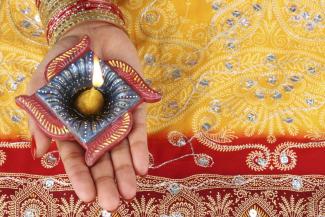
Do the preparation task first. Then read the article and do the exercises.
Preparation
Diwali comes from the word deepavali, which means 'rows of lighted lamps'. During the festival, these lamps, called diyas, are used everywhere. They symbolise the victory of light over darkness, or good over evil.
Diwali is celebrated differently in different regions and by different religions and is a bank holiday in many countries, including India, Sri Lanka, Nepal, Myanmar, Singapore, Malaysia, Mauritius, Fiji, Guyana, Suriname and Trinidad and Tobago. It is often considered a Hindu festival, but in fact it is also celebrated by Sikhs, Jains and Newari Buddhists.
Here are some of the things that happen during the five days of Diwali.
Day One – Dhanteras, or Day of Fortune
The first day has a focus on fortune, both good luck and money or valuables. People may wash money to show that they intend to use it to do good in the world. It is also a day for helping people who are not as well off.
It is a lucky day for buying gold and silver and other metals, so people often buy jewellery or cars, or anything made of metal. It is estimated that last year Indians spent about $3.9 billion during Diwali.
People also make sure that their houses are clean, ready to welcome in Lakshmi, the Goddess of Wealth and Prosperity, in the evening.
Day Two – Naraka Chaturdashi
According to Hindu stories, the demon Narakasura was killed on this day. The day is all about getting rid of anything bad. People get up early and wash and put on clean or new clothes.
Afterwards, they will celebrate by having a special breakfast with their friends and family. This day, also known as Chhoti Diwali, is a day for visiting friends, business associates and relatives, and for exchanging gifts.
Day Three – Diwali
In most regions, this is the most important day of the festival. It is the last day of the year in many regions of India. The story goes that on this day, Lord Rama rescued his wife, Sita, from the demon Ravana. Candles are lit to celebrate his victory, and to light his way home after the battle. In the evening, people may set off fireworks.
Day Four – Annakut
Annakut means 'mountain of food'. Hindus prepare a great deal of food and take it to the temple to celebrate the beginning of the new year.
Food is important throughout the period of Diwali, especially traditional sweet treats such as gulab jamun (a very sweet deep-fried doughnut), kheer (a creamy dessert made with rice) or barfi (a sweet made with condensed milk and sugar).
Day Five – Bhai Dhooj
This is the last day of Diwali, and it also sometimes celebrates the relationship between brother and sister. Brothers may visit their married sisters' homes, and they will take gifts.
A universal symbol
Diwali is celebrated by millions of people in India and across the world. The festival marks different historical events and stories for each faith that celebrates it, but for all the faiths it symbolises the victory of good over evil, and darkness over light, which means something to all of us.




Hello HRN1970,
Yes, you are quite right! Well spotted, and thank you for pointing this out. I'll edit the text accordingly.
Peter
The LearnEnglish Team